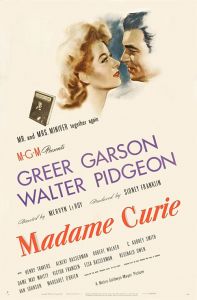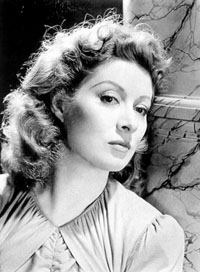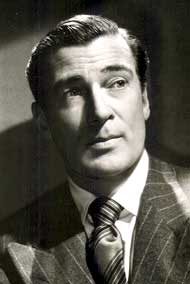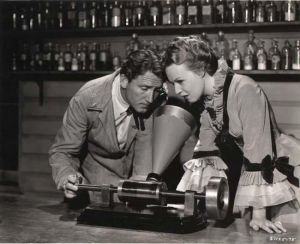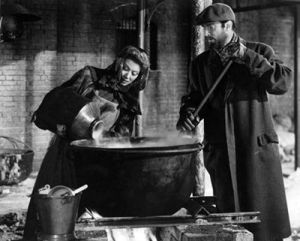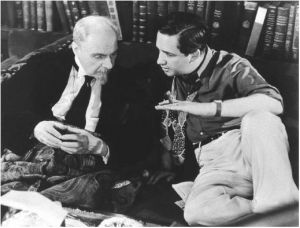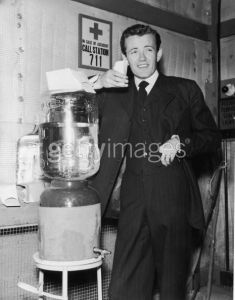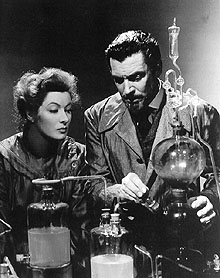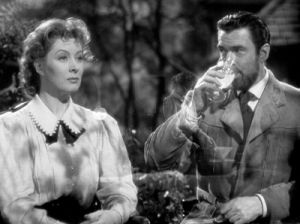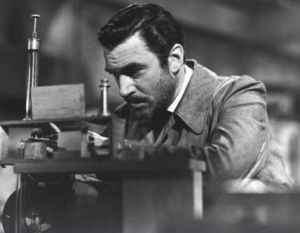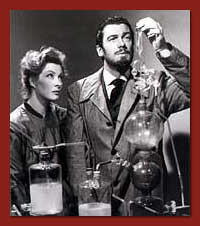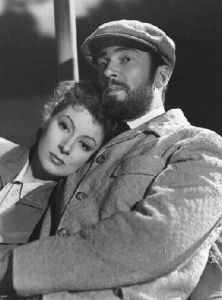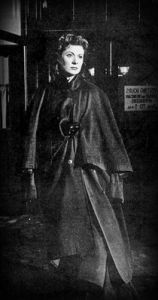Madame Curie 居里夫人
Madame Curie (居里夫人) is a 1943 biographical film made by MGM (Metro-Goldwyn-Mayer 美国米高梅电影制片公司). It was directed by Mervyn LeRoy and produced by Sidney Franklin adapted from the biography by Eve Curie about her mother. The leading roles Greer Garson and Walter Pidgeon team for the third time in the film which tells the story of Polish-French physicist Marie Curie.
Directed by: Mervyn LeRoy
Produced by: Sidney Franklin
Written by: Aldous Huxley (uncredited), Paul Osborn
Music by: Herbert Stothart, William Axt
Cinematography: Joseph Ruttenberg
Distributed by: Metro-Goldwyn-Mayer
Release date: December 15, 1943 (Los Angeles premiere)
Running time: 124 minutes
Country: United States
Language: English
Color: Black and White
Genre: Biography Drama
Greer Garson as Marie Curie
Henry Travers as Eugene Curie
Albert Bassermann as Prof. Jean Perot
Robert Walker as David Le Gros
C. Aubrey Smith as Lord Kelvin
Dame May Whitty as Madame Eugene Curie
Walter Pidgeon as Pierre Curie
Victor Francen as President of University
Elsa Basserman as Madame Perot
Reginald Owen as Dr. Becquerel
Van Johnson as Reporter
Margaret O'Brien as Irene Curie (at age 5)
James Hilton as Narrator (voice)
Marie Sklodowska (Greer Garson) is a poor, idealistic student living in Paris and studying at the Sorbonne. She neglects her health and one day faints during class. Her tutor, Prof. Perot (Albert Bassermann) is sympathetic and, finding that she has no friends or family in Paris, invites her to a party his wife is throwing for a "few friends".
Among the many guests is physicist Pierre Curie (Walter Pidgeon), an extremely shy and absentminded man completely devoted to his work. He allows Marie to share his lab and finds that she is a gifted scientist. Appalled that she plans on returning to Poland to teach after graduation, rather than devoting her life to further study, he takes her to visit his family in their country home. Marie and Pierre both tend to concentrate on science to the extent that they don't realize until the last minute they have fallen in love. Even when Pierre asks Marie to be his wife, he does so in terms of reason, logic and chemistry.
Fascinated by a demonstration she saw as an undergraduate, of a pitchblende rock that seems to generate enough energy to take small photographs, Marie decides to make the rock's energy that the subject of her doctoral study. The measurements she takes don't seem to add up, and she decides there must be a third radioactive element in the rock in addition to the two she knows are in there. However, in the midst of discussing this, she discloses offhandedly to Pierre's family that she's pregnant.
The physics department at the Sorbonne refuses to fund their research without more proof of the element's existence, but allows them to use a dilapidated old shed across the courtyard from the physics building. In spite of its disadvantages, they import eight tons of pitchblende ore and cook it down to look for the element they call radium. In spite of inability to separate out pure radium, they know something is definitely there, as Marie's hands are being burned. They hit on a tedious method of crystallization to arrive at pure radium.
Now world-famous, they go on vacation to rest after all the press conferences and the Nobel Prize. They're granted a new laboratory by the university; before its dedication Marie shows off her new dress, inspiring Pierre to go get her a set of earrings to go with it. Walking home in the rain, he absentmindedly crosses the street in front of a delivery wagon and is run down and killed. Marie almost loses her mind, but after the concerned Prof. Perot counsels her, she rallies when she remembers Pierre's words that if one of them should die, the other must go on just the same. The film concludes with a speech she gives at the 25th anniversary celebration of the discovery of radium, expressing her belief that science is the path to a better world.
On the Discovery of Radium
by Marie Curie
I could tell you many things about radium and radioactivity and it would take a long time. But as we can not do that, I shall only give you a short account of my early work about radium. Radium is no more a baby, it is more than twenty years old, but the conditions of the discovery were somewhat peculiar, and so it is always of interest to remember them and to explain them.
We must go back to the year 1897. Professor Curie and I worked at that time in the laboratory of the school of Physics and Chemistry where Professor Curie held his lectures. I was engaged in some work on uranium rays which had been discovered two years before by Professor Becquerel.I spent some time in studying the way of making good measurements of the uranium rays, and then I wanted to know if there were other elements, giving out rays of the same kind. So I took up a work about all known elements, and their compounds and found that uranium compounds are active and also all thorium compounds, but other elements were not found active, nor were their compounds. As for the uranium and thorium compounds, I found that they were active in proportion to their uranium or thorium content. The more uranium or thorium, the greater the activity, the activity being an atomic property of the elements, uranium and thorium.Them I took up measurements of minerals and I found that several of those which contain uranium or thorium or both were active. But then the activity was not what I could expect, it was greater than for uranium or thorium compounds like the oxides which are almost entirely composed of these elements.Then I thought that there should be in the minerals some unknown element having a much greater radioactivity than uranium or thorium. And I wanted to find and to separate that element, and I settled to that work with Professor Curie. We thought it would be done in several weeks or months, but it was not so. It took many years of hard work to finish that task. There was not one new ,lenient, there were several of them. But the most important is radium, which could be separated in a pure state.Now, the special interest of radium is in the intensity of its rays which several million times greater than the uranium rays. And the effects of the rays make the radium so important. If we take a practical point of view, then the most important property of the rays is the production of physiological effects on the cells of the human organism.
These effects may be used for the cure of several diseases. Good results have been obtained in many cases. What is considered particularly important is the treatment of cancer. The medical utilization of radium makes it necessary to get that element in sufficient quantities. And so a factory of radium was started to begin with in France, and later in America where a big quantity of ore named carnotite is available. America does produce many grams of radium every year, but the price is still very high because the quantity of radium contained in the ore is so small. The radium is more than a hundred thousand times dearer than gold.But we must not forget that when radium was discovered no one knew that it would prove useful in hospitals. The work was one of pure science. And this is a proof that scientific work must not be considered from the point of view of the direct usefulness of it. It must be done for itself, for the beauty of science, and then there is always the chance that a scientific discovery may become like the radium a benefit for humanity.The scientific history of radium is beautiful. The properties of the rays have been studied very closely. We know that particles are expelled from radium with a very great velocity near to that of the light. We know that the atoms of radium are destroyed by expulsion of these particles, some of which are atoms of helium. And in that way it has been proved that the radioactive elements are constantly disintegrating and that they produce at the end ordinary elements, principally helium and lead. That is, as you see, a theory of transformation of atoms which are not stable, as was believed before, but may undergo spontaneous changes.
Radium is not alone in having these properties. Many having other radio-elements are known already, the polonium, the mesothorium, the radiothorium, the actinium. We know also radioactive gases, named emanations. There is a great variety of substances and effects in radioactivity. There is always a vast field left to experimentation and I hope that we may have some beautiful progress in the following years. It is my earnest desire that some of you should carry on this scientific work and keep for your ambition the determination to make a permanent contribution to science.
In March 1938, Anita Loos (an American screenwriter) contacted Aldous Huxley, then recently moved to Hollywood, saying she would put him in touch with MGM for a writing contract. MGM ultimately rejected Huxley's script for Madame Curie as "too literary".
Madame Curie was originally to star Greta Garbo and be directed by George Cukor. Mervyn LeRoy replaced Albert Lewin, who was fired shortly before production began.
In her final years at MGM, Joan Crawford (an actress stayed with MGM for 18 years) was handed weak scripts in the hopes that she'd break her contract. Two films she hungered to appear in were Random Harvest (1942) and Madame Curie (1943). Both films went to bright new star Greer Garson instead, and Crawford left the studio soon after.
The film is heavily fictionalized for dramatic purposes and completely omits any mention of Marie's family in Paris, including her sister Bronislawa, an obstetrician, with whom she was very close. There is also virtually no mention of Marie's intense devotion to politics and the independence of her native Poland.
When Marie gets out of the chair, her hand is at first in her lap, but then on the arm rest.
When Pierre looks at the final crystalization, Marie has a shawl over both shoulders, then only the right, then on both again but pulled back slightly, then on both again fully.
When Pierre and Marie wake up from their nap in the lab, the blanket is on the shoulder in one cut, but off in the next.
When his parents come over for dinner, Pierre comes out of the kitchen to get his coat twice.
After Pierre's street accident, when the men come to tell Marie, she comes into the hallway and puts her hand on the dowel of the railing; in the next shot, her hand is down, and she puts it up on the dowel again.
This picture illustrates everything wonderful about the confidence, expertise and narrative power of Hollywood films near the end of the classic period: it is entertaining, intelligent and carefully made in every department. A smooth celebration of scientific theory and of the romantic partnership of two scientists.
Here we have Greer Garson in the kind of role that would later inspire that wonderful sequence from 'Ziegfeld Follies' (the 'Madame Crematon' impersonation by Judy Garland, a rip-off of Greer in her great lady roles). But, surprisingly or not, Garson and Pidgeon are teamed in a very eloquent and moving biography, one of the more tasteful and dignified bios of the 1940s considering it deals with subject matter not conducive to popular taste.
Oscar (Academy Awards, USA)
Best Actor in a Leading Role, Walter Pidgeon
Best Actress in a Leading Role, Greer Garson
Best Art Direction-Interior Decoration, Black-and-White, Cedric Gibbons, Paul Groesse, Edwin B. Willis, Hugh Hunt
Best Cinematography, Black-and-White, Joseph Ruttenberg
Best Music, Scoring of a Dramatic or Comedy Picture, Herbert Stothart
Best Picture
Best Sound, Recording, Douglas Shearer (M-G-M SSD)
http://www.oushe.cn/p/OS200710012544.html
http://baike.baidu.com/view/3614.htm
http://forum.book.sina.com.cn/redirect.php?fid=27&tid=2447106&goto=nextoldset
附件列表
词条内容仅供参考,如果您需要解决具体问题
(尤其在法律、医学等领域),建议您咨询相关领域专业人士。
如果您认为本词条还有待完善,请 编辑
上一篇 Forrest Gump 阿甘正传 下一篇

